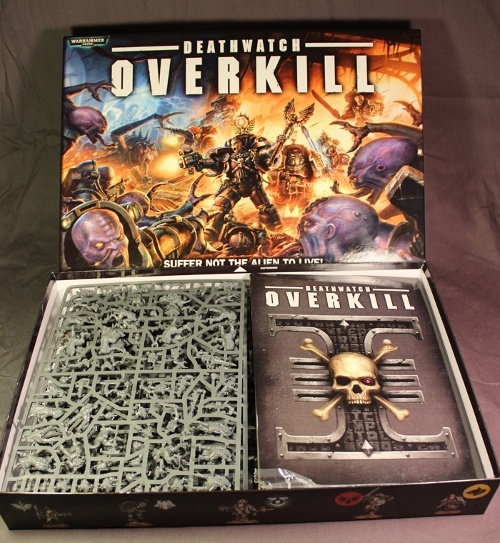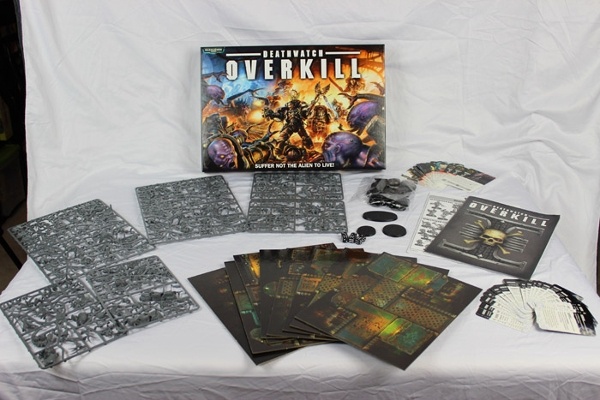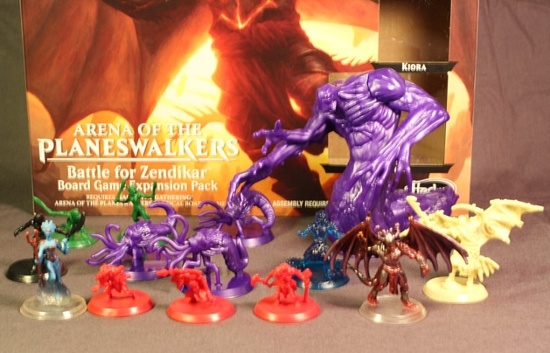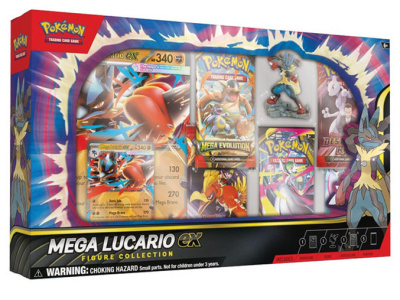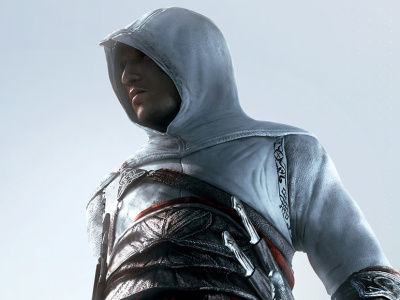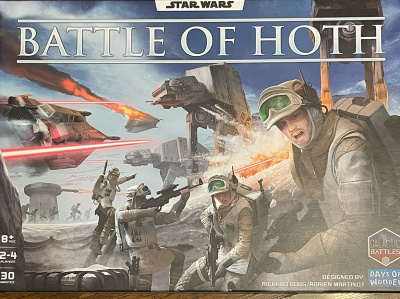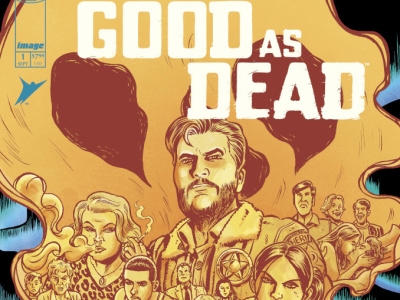Deathwatch: Overkill
Publisher: Games Workshop
MSRP: $165.00
Release Date (US): March 2016
Players: 2
Playing Time: 60+ minutes
Ages: 16 and up
Product #: DW1-60
ICv2 Rating: 3.5 Stars out of 5
More than a few years ago, your humble reviewer was introduced to the world of Space Marines for the first time. There was a new board game making the rounds then, by the unassuming name of Space Hulk. It wasn’t long after I had acquired a VHS (!) copy of the fantastic sci-fi action thriller Aliens (which was watched many, many times), and the marines versus alien monsters theme resonated deeply in this teenaged boy’s mind. It was fertile ground for Space Hulk, and it took root, leading to a life-long love of miniatures gaming. Now, a few years later, Games Workshop is presenting a very different take on the Space Marines vs. Genestealers story: Deathwatch: Overkill.
Summary: Deathwatch: Overkill pits a small team of highly-elite Space Marines in powered armor bearing a mind-blowing assortment of advanced weaponry against an uncountable horde of human-alien hybrids known as Genestealers. Over nine missions, these two groups compete to complete their objectives or prevent their enemies from doing so. Scenarios range from the basic "kill the bad guy" to more sophisticated rescue operations, run-the-gauntlet confrontations, or search-and-destroy missions. The action takes place in a strip mine on an alien world, with warriors fighting across metal gantries and walkways suspended over a yawning abyss--a brutal free-fire zone composed of cramped, narrow walkways and limited mobility.
Originality: While the theme is nothing new to the so-called "Grimdark Universe," and the combat system is tried-and-true, there are some features of Deathwatch: Overkill that give it a fresh feeling and a different play experience. Most noticeable is the open nature of the game board. There is no cover or passageways to navigate, which in turn eliminates any need for convoluted line-of-sight rules. Movement is area-based, and each space can literally hold exactly as many models as a player can fit in them--large combatants, like the massive Genestealer Patriarch or a Space Marine riding an assault motorcycle, have much larger bases than the smaller Genestealer hybrids--if you can’t fit its base in the space, your model can’t enter. Interestingly, while movement is area based, combat is resolved using a range ruler in a style more like tabletop miniatures games. This combination of abstracted movement and structured combat creates a surprising depth of tactical options, and results in a unique feel for the game.
Presentation: Beautiful, in that dark and brooding way that is the trademark of Games Workshop. The artwork on the box is fantastic (and pays a subtle homage to the cover of the game’s predecessor), full of dramatic color and action. The boards are glossy, with the movement spaces slightly embossed, splendidly decorated with mine equipment partially visible "below" the walkways. The models are some of the finest examples of Games Workshop sculpting to date: every Space Marine is unique, and the large number of Genestealer variants makes the alien force look really sharp. And GW not being one to shy away from excessively establishing background, the rules are interspersed with fabulous artwork, pictures of painted models, and the complete backstory of the campaign, told from the point of view of the marines themselves.
It is worth warning, however, that these are true Games Workshop models. That means that a lot of assembly is required before play can begin: either a few evenings in front of the TV (firing up Aliens is a good way to get in the mood…) or a solid Saturday afternoon will need to be set aside for this. Clippers, files, and modeling glue are essential tools as well.
Quality: The component quality is top-notch, continuing the trend of recent board game releases from GW. I’m also pleased to announce that they continue to improve their packaging, with protective shrink-wrap and even a layer of bubble wrap shielding the printed components from potential scratches from the plastic model sprues. The game rules are concise and easy to read, but really would have benefited from more examples of play. While I personally delight in the modeling side of the hobby, and both enjoyed assembling the models and look forward to painting them, when looking at Deathwatch: Overkill as a game rather than a model kit, I am concerned at the difficulty to be had in attempting to store the models in the box once assembled. The larger models barely fit in the box, and I am concerned about breakage of some of the more delicate components.
Marketability: Deathwatch: Overkill seems determined to set new records for the price of a board game at $165, which would be an outrageous price if it was, in fact, simply a board game. But it is more than that, as it is a combination board game and model kit: 50 highly-detailed plastic miniatures are included in the box, and they are not available separately. A comparable assortment of models from the Warhammer 40,000 line would cost well over $200. Between the price and the assembly required to play, the appeal of this game is going to vary highly from one gaming community to the next.
Overall: Setting all nostalgia aside and examining Deathwatch: Overkill on its own merits, I have to say that it is a solid play. The rules are very streamlined, offering only the bare bones required to play the game. The combination of mechanics is innovative, and the asymmetrical nature of the two combatants creates a lot of interesting tactical challenges. I am a bit concerned about some balance issues, as the Space Marines seem very strong, but I think that as a player’s skill improves, their ability to use the Genestealers’ Gambit cards may correct that. I really like the way the scenarios are linked together in a campaign, with the results from one game affecting later games, but I know that I’m going to want more scenarios quickly after I’ve played through those a few times. In particular, more variety of battlefields to fight over would be most welcome.
Deathwatch: Overkill is a fun, solid tactical board game with lots of cool toys and a lot of potential for future growth, but it’s not a game for everyone--unless they have a friend that loves to put models together. I give this game 3.5 out of 5.
And for what it’s worth: Deathwatch: Overkill offers an entirely different feel than Space Hulk. I’m happy to have both in my collection and can see playing both of them again and again. And that’s even with the nostalgia.
--William Niebling
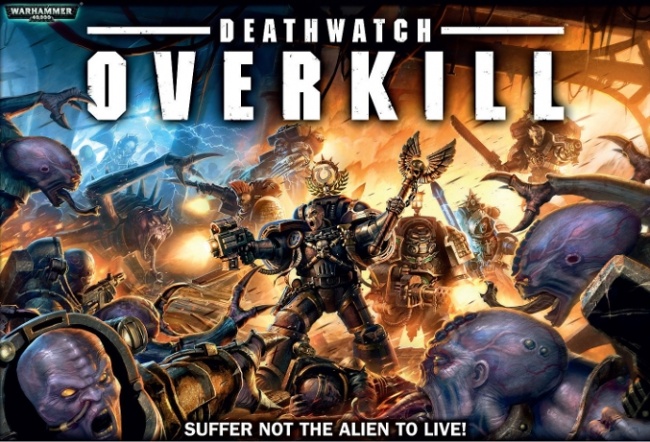
ICv2 Stars: 3.5 (out of 5)
Posted by William Niebling on April 7, 2016 @ 4:28 am CT
MORE GAMES
New Boxed Set
August 22, 2025
The Pokemon Company International will release Pokemon TCG: Mega Lucario ex Figure Collection, a new boxed set, into retail.
Offers Retail Tier
August 22, 2025
Mantic Games' Assassin's Creed: Animus has hit Kickstarter and has a retail rewards tier.
MORE REVIEWS
ICv2 Stars: 4 (out of 5)
August 21, 2025
Here is a review of Days of Wonder's Star Wars: Battle of Hoth board game.
From Image Comics
August 18, 2025
Here's a preview of Good as Dead #1, by David & Maria Lapham.



